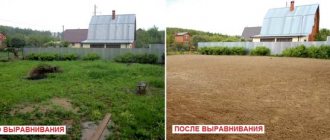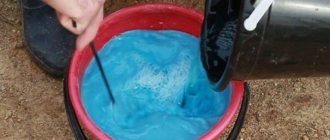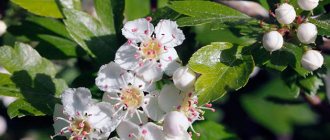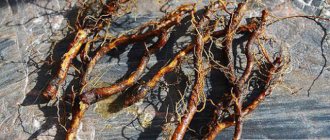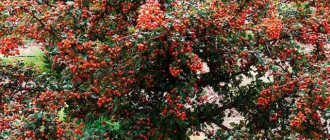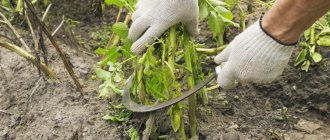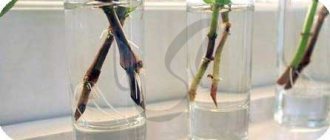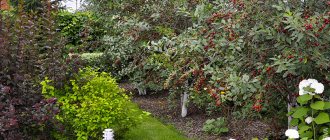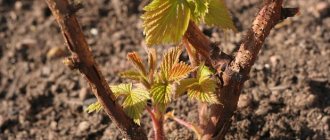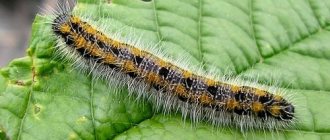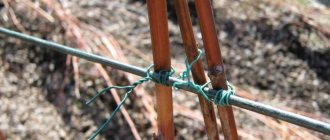Popular varieties and types of hawthorn
Common hawthorn, also known as thorny hawthorn (Crataegus laevigata) . A tree or large spreading shrub, up to 4-5 m high. The shoots are numerous, hard, covered with sharp long thorns. The flowers are simple, white, rather large.
Description of hawthorn varieties of this type
"Gireoudii" is a small variegated tree on a trunk or bush. Young leaves are pink. Snow-white bloom. Since the decorative value of the variety lies in the foliage, the plant can be regularly trimmed to any height to maintain a beautiful shape.
Pink hawthorn 'Rosea Flore Pleno' and 'Alba Plena' with numerous white or soft pink small double flowers.
'Crimson Cloud' has showy red-pink simple flowers with a white spot at the base of the petals.
Single-petaled hawthorn (Crataegus monogyna) . It is characterized by shorter spines, elongated, strongly lobed leaves and a height of 3-6 meters. Some varieties have no spines. The crown is dense and dense. Variations of this species are highly decorative and have different crown shapes, which can be weeping or pyramidal.
The flowers are simple or double, pink, crimson, white, less often bicolor. There is also a variegated group and a magnificent variety that blooms throughout the summer months.
Among the noted varieties of hawthorn, the following are popular:
- Variegata group with variegated white-green or cream-green leaves;
— “Stricta” is a tree with a narrow, pyramidal growth habit and white flowering;
— “Compact” group — dwarf slowly growing bushes or trees with a spherical crown with a diameter of less than 1 meter, mainly on a trunk;
— pink decorative hawthorn “Rose” with dark pink petals on top and a white center;
One of the most ornamental shrubs is the intraspecific hybrid of hawthorn - Crataegus x media and its varieties:
- magnificent double hawthorn “Pauli Scarlet” with soft pink flowers that abundantly cover the shoots of a low tree;
- "Rubra Plena" - red-pink flowers have a lighter shade of petals on the underside, which gives a more interesting color effect.
Also popular among gardeners are the Dzungarian hawthorn with large and unusual black fruits, the red-fruited Arnold hawthorn (Crataegus arnoldiana) and the yellow hawthorn of the “Aurea” group.
Caring for hawthorn in open ground
Along with its decorative qualities, the crop is distinguished by its hardiness, so growing and caring for hawthorn will not be a problem. It is enough to irrigate the plantings once a month or 2-3 times during the dry season. A bucket is enough for one bush.
You might be interested to know what flowers are planted in spring
After irrigation, loosen the soil so that a crust does not form, preventing oxygen from reaching the roots. In the spring, before flowering, they feed with rotted mullein, diluted in water in a ratio of 1:10. Fertilizer is enough for the entire growing season and fruiting.
Hawthorn pruning
Sanitary and formative pruning of hawthorn is carried out in the spring, before growth begins. It is not recommended to radically shorten the shoots, as this will affect the flowering of the current season. But if flowering is not the main thing for you, then using figured cutting you can create beautiful topiary figures from trees.
Rosea Flore Pleno
Remove root shoots, damaged and dry branches. To obtain a low bush form, trim the shoots by 2-3 cm every year, maintaining the desired height. The shoots of young hawthorn hedge seedlings are shortened annually for 3-4 years by half their growth until the hedge reaches the required height. Then only corrective pruning of the hawthorn is needed in the summer after flowering.
Description
As can be seen in the photo of the shrub, hawthorn is a deciduous, less often semi-evergreen plant, reaching a decent height of up to 2-3 m. If you form it in the form of a tree, you will get a dense round or cone-shaped crown with the presence of prickly purple-red shoots. The height of trees can be 5-7 m and higher. North American hawthorns have long spines up to 5-9 cm, sometimes up to 12 cm. They have a very sharp tip, so it is very difficult to work with the plant, harvest berries and move near the plantings. Some varieties of European hawthorns do not have thorns or they are small - up to 2-3 cm. In the process of work, the hands can be injured by these thorny shoots.
If we consider the description of the Common hawthorn, we can note its decorative value during the growing season, since its graceful leaves in the fall attract others with orange-red tones, numerous white flowers in thyroid inflorescences, large bright and edible fruits. They stay on the crown for up to 2 months and can be orange-yellow, pink, bright red and even black. In summer, the graceful leaves on the branches are dark green, whole or lobed.
The flowering phase begins in May-June ; the photo shows the flowering of hawthorn. Buds of 20 pieces are collected in inflorescences-corymbs. with white or pink petals. It is the small flowers, up to 3 cm in diameter, that give the bushes splendor, as they are tightly arranged in the corymbs. There are varieties of the crop with simple or double flowers, but all of them have beautiful stamens and brightly colored anthers. With abundant and spectacular flowering before the leaves appear on the branches, the inflorescences emit a repulsively unpleasant aroma. This metamorphosis occurs due to the substance dimethylamine in the structure of the flowers with the characteristic smell of stale fish.
The tree may not always bear fruit, since hawthorn (pictured) occasionally blooms during the rainy season. In dry and sunny weather after flowering, the fruits, ranging in size from 5-7 mm to 3 cm, are large, round, pear-shaped or elongated. At their top, the pulp under the skin contains triangular hard seeds - up to 5 pieces. Fruiting begins at the age of the tree - 8-10 years .
This crop withstands unfavorable urban conditions well, is undemanding to soil, and grows well in soil with lime. The tree can withstand partial shade, drought and frost. It has a high shoot-forming ability, so it can and should be cut and shaped.
Propagation of hawthorn by seeds
Obtaining young seedlings from seeds takes a very long time. For successful germination, planting material requires long-term cold stratification from 12 to 18 months.
You can reduce this time slightly by soaking the seeds overnight in warm water and then placing them in a damp mixture of peat and sand in a bag or plastic box. Before sowing, they are kept in a dark place for 3 months at a temperature of 15 °C, and then another 3 months at a temperature of 4 °C.
Other methods to speed up the germination process include scarifying the seed before sowing or fermenting it for several days in fruit pulp. Not quite mature seeds are best suited for sowing, which are sown immediately in open ground in late autumn or in the spring after stratification.
How to grow
Hawthorn - cultivation and care includes: propagation using grafting, layering, root cuttings, seeds.
The seeds have a very hard shell and a long dormant period, so seedlings can be obtained from them after 1.5-2 years and only after stratification for 6-12 months. Seeds are taken from unripe fruits, filled with water for 1-2 days, passed through a sieve and dipped in a solution of potassium nitrate (potassium nitrate - 1%). Sow the seeds thickly in the ground before winter. Empty seeds will not germinate, so the planting will not be too dense. Like an apple tree, the seedlings will grow 10-12 cm in height in the first year. Next year in the spring they can be transplanted from containers with soil for growing. After 2-3 years, a seedling up to 60 cm tall should be cut to 2-3 buds above ground level. Then the side shoots will begin to grow actively, of which 2 are left, the rest are cut off.
To plant a hedge, you can use root suckers or second-year seedlings, which are cut at a level of 10-15 cm from the soil. After the shoots grow, only 1-2 are left. They are planted at a distance of 15-20 cm and tilted towards each other. Then you can intertwine the growing shoots with each other. When the hedge becomes thick and tall, it is trimmed in spring or mid-summer.
Propagation of hawthorn by cuttings
Unfortunately, this method does not give 100% results. For propagation, flexible semi-lignified shoot tips 15-20 cm long are cut off just below the node. The lower leaves are torn off.
The cut is dipped in root growth stimulating powder and buried in a mixture of perlite, sand and universal soil in a ratio of 1:1:2. Water the mixture well and cover the pot with a bag or plastic bottle. Monitor soil moisture and periodically ventilate the greenhouse.
Usually roots form after 20-30 days. When the seedling begins to form leaves, it can be transplanted into open ground. For the first 2 years, the hawthorn is covered with fallen leaves for the winter and watered regularly.
Diseases and pests of hawthorn
The disadvantage of the ornamental hawthorn shrub is its low resistance to a number of fungal and bacterial diseases and pests.
Common diseases include scab, powdery mildew caused by excess moisture and poor air circulation, rust and various types of leaf spot.
To prevent the development of diseases, it is recommended to treat plantings with special preparations twice a season in March and autumn. To prevent the spread of diseases, fallen leaves are collected and burned in the fall.
How to get rid of aphids using traditional methods can be read in this article
Hawthorn pests: aphids, caterpillars, leaf rollers, scale insects and the hawthorn butterfly, which lays eggs in inflorescences.
Possible diseases
Like all plants, hawthorn is not immune to damage from pests or diseases. The most common are: Powdery mildew - the formation of a white coating on the leaves of a plant, which curls the leaves as it dries. Infected shoots must be pruned and the plant treated with fungicides. After 14 days, re-treat the bush;
Leaf spotting of different colors (yellow, brown, white) - in all cases, the leaves are affected by small spots and subsequently dry out. To combat stains, hawthorn is treated with a 1% solution of copper sulfate or copper oxychloride. To prevent infection, the plant is treated in the spring, before buds appear, and in the fall, after the leaves fall. It is recommended to burn all infected leaves and sprouts; Apple aphid - spoils young leaves by sucking their juice, causing the leaves to curl and wither. You can fight such a parasite with folk remedies (tincture of garlic or tobacco with soap) or buy a solution of karbofos, phosphamide (dilute according to the instructions);
Leaf roller - caterpillars feed on leaves, rolling them into tubes with their web, and then eat buds, leaves and ovaries. To combat it, treat the hawthorn with chlorophos, and for prevention in the spring, treat it with nitrophen;
The hawthorn butterfly is content with the nectar of a flowering plant and lays eggs on the outside of the leaves; subsequently, the caterpillars eat both the buds and leaves. To combat them, Karbofos is used.
